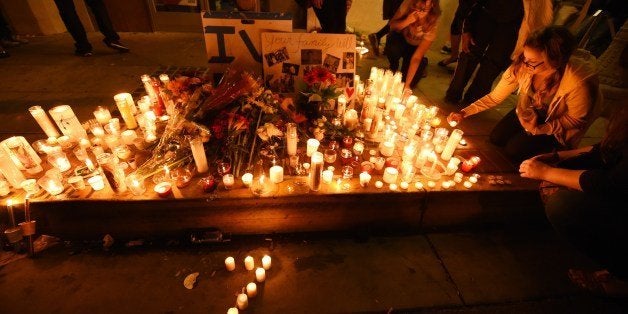
Topher McDougal and Robert Muggah*
Even before the massacre of six people in Santa Barbara had reached its bloody conclusion, the Great American Gun debate was taking shape. Some headlines described a deranged lunatic intent on retribution against women. Others honed in on the premeditated nature of the killing spree and argued that better armed civilians could have prevented the carnage. Still more highlighted how access to a semi-automatic pistol dramatically increased the number of dead and injured. All too familiar battle lines were being drawn. On one side are those who explain these ghastly incidents as the outcome of a failed mental health system. On the other are pundits who say these preventable deaths are the consequence of America's patent inability to regulate guns. They are both right.
The Great American Gun debate has reached fever pitch in the eighteen months since the 2012 Newtown shootings that left twenty young children and six adults dead. The single largest school shooting in US history generated a rash of pledges from US legislators for mental health reform and promises to strengthen regulatory controls over firearms. These recommendations hit a number of roadblocks from the moment they were tabled. The National Rifle Association (NRA) made its opposition known from the beginning. More subtle critics also cautioned against moving too quickly. As legislators know well, there is a need to balance Constitutional rights with the responsibilities that such rights entail at home and abroad. And while discussions continue, mass shootings continue unabated: there have been at least 44 since late 2012.
And while passions are running high, it is important that cooler heads prevail in the Great American Gun debate. This is because the factors giving rise to gun violence are more complex than they first appear and merit careful and well thought out solutions. Part of the answer surely resides in expanding the quality and coverage of mental health service provision. Improving public safety will also demand targeted firearms regulation measures, not least background checks for private sales, restrictions on assault rifles and handguns, and limits on the sizes of ammunition magazines. Finding the appropriate balance will require mobilizing good evidence of what works and what does not. And this in turn necessitates accessible, reliable and credible data. Oddly, what is missing from the debate is the most rudimentary information needed to diagnose and treat gun-related violence. And the reasons for this are widely known.
It seems that one side of the Great American Gun debate has repeatedly withdrawn information that might strengthen the argument of its opponents. A good example of this occurred in 1996 when, under pressure from the pro-gun lobby, Congress ended virtually all publicly funded health research on gun violence. The firearms research program of the internationally respected Centers for Disease Control and Prevention (CDC) was stripped of roughly 96 per cent of its support. Government resources committed to firearms-related research amounted to about 0.0018% of the CDC's 2013 budget. If firearm deaths constitute roughly 1.3 per cent of all national mortality, it could be convincingly argued that the CDC's budget should have been 722 times larger. A recent bill by Rep. Carolyn Maloney (D-NY) and Sen. Ed Markey (D-MA) aims to restore the CDC's funding for firearms research - a bill the NRA has labelled "unethical." These muzzling tactics have an earlier precedent.
The US Bureau for Alcohol, Tobacco, Firearms and Explosives (ATF) has been prohibited since 1978 from compiling data on firearms sales. The prohibition on collecting information has required the research community to rely on household surveys to estimate the access and sale of guns and ammunition among civilians. The best estimate available suggests there are about 300 million in circulation, or around one firearm per citizen. A Texan gun store recently issued an inflammatory sign touting "undocumented' guns. The owners were closer to the truth than they imagined: no one knows how many legally sold firearms there are in the US, documented or otherwise. This knowledge gap is compounded by the fact that the Federal Bureau of Investigation (FBI) has been banned since 2003 from from gathering data for the National Instant Criminal Background Check System (NICS) that it is required by law to administer on behalf of gun stores.
While these checks on data may preserve some aspects of the individual right to privacy, they amount to an assault on public safety. And it is not just Americans who are affected. In 2013, we tried to better understand the scope and scale of gun trafficking from the US to Mexico. There are more than 54,000 federally licensed gun shops in the US and just one in Mexico city. In the absence of information on US firearms purchases and owing to the partial data from Fast and Furious, we developed an alternate methodology that made use of the ATF's data on gun retail licenses per county and their distance from the US border. In a new peer reviewed journal article, we estimate that there were over 210,000 guns being smuggled across the border each year.
And while our findings were covered extensively in the US and Mexican press, such facts and figures have yet to move the government to take positive action. In fact, the reverse is true. One month after the release of our report, a Congressional rider was introduced to the ATF's appropriation statute that prohibited the agency from compiling data on the very gun stores it is mandated to license. This means that the very same data we had used to estimate the illicit flow of guns to Mexico is no longer available to the public. Rather than pursuing a more open strategy to encourage vibrant debate, US Congress appears to be shutting the door on evidence-based reflection and action.
Topher McDougal and Robert Muggah are two founding members of the Small Arms Data Observatory (SADO), an international consortium of researchers committed to the quantitative study of the production, trade and effects of firearms across the Americas.